Related Research Articles

The Defense Advanced Research Projects Agency (DARPA) is a research and development agency of the United States Department of Defense responsible for the development of emerging technologies for use by the military.

The Semi-Automatic Ground Environment (SAGE) was a system of large computers and associated networking equipment that coordinated data from many radar sites and processed it to produce a single unified image of the airspace over a wide area. SAGE directed and controlled the NORAD response to a possible Soviet air attack, operating in this role from the late 1950s into the 1980s. Its enormous computers and huge displays remain a part of cold war lore, and after decommissioning were common props in movies such as Dr. Strangelove and Colossus, and on science fiction TV series such as The Time Tunnel.

PARC is a research and development company in Palo Alto, California. It was founded in 1969 by Jacob E. "Jack" Goldman, chief scientist of Xerox Corporation, as a division of Xerox, tasked with creating computer technology-related products and hardware systems.

Whirlwind I was a Cold War-era vacuum tube computer developed by the MIT Servomechanisms Laboratory for the U.S. Navy. Operational in 1951, it was among the first digital electronic computers that operated in real-time for output, and the first that was not simply an electronic replacement of older mechanical systems.
The Information Processing Techniques Office (IPTO), originally "Command and Control Research", was part of the Defense Advanced Research Projects Agency of the United States Department of Defense.

Raytheon BBN is an American research and development company based in Cambridge, Massachusetts, United States.

The Advanced Research Projects Agency Network (ARPANET) was the first wide-area packet-switched network with distributed control and one of the first computer networks to implement the TCP/IP protocol suite. Both technologies became the technical foundation of the Internet. The ARPANET was established by the Advanced Research Projects Agency (ARPA) of the United States Department of Defense.

Joseph Carl Robnett Licklider, known simply as J. C. R. or "Lick", was an American psychologist and computer scientist who is considered to be among the most prominent figures in computer science development and general computing history.

Computer Science and Artificial Intelligence Laboratory (CSAIL) is a research institute at the Massachusetts Institute of Technology (MIT) formed by the 2003 merger of the Laboratory for Computer Science (LCS) and the Artificial Intelligence Laboratory. Housed within the Ray and Maria Stata Center, CSAIL is the largest on-campus laboratory as measured by research scope and membership. It is part of the Schwarzman College of Computing but is also overseen by the MIT Vice President of Research.
The MIT Lincoln Laboratory, located in Lexington, Massachusetts, is a United States Department of Defense federally funded research and development center chartered to apply advanced technology to problems of national security. Research and development activities focus on long-term technology development as well as rapid system prototyping and demonstration. Its core competencies are in sensors, integrated sensing, signal processing for information extraction, decision-making support, and communications. These efforts are aligned within ten mission areas. The laboratory also maintains several field sites around the world.

Intergalactic Computer Network or Galactic Network (IGCN) was a computer networking concept similar to today's Internet.

Intelligence amplification (IA) refers to the effective use of information technology in augmenting human intelligence. The idea was first proposed in the 1950s and 1960s by cybernetics and early computer pioneers.
The Alvey Programme was a British government sponsored research programme in information technology that ran from 1984 to 1990. The programme was a reaction to the Japanese Fifth Generation project, which aimed to create a computer using massively parallel computing/processing. The programme was not focused on any specific technology such as robotics, but rather supported research in knowledge engineering in the United Kingdom. It has been likened in operations to the U.S. Defense Advanced Research Projects Agency (DARPA) and Japan's ICOT.
Jack P. Ruina was an American electrical engineer who was a professor of electrical engineering at the Massachusetts Institute of Technology (MIT) from 1963 until 1997 and thereafter an MIT professor emeritus. From 1966 to 1970, he was also vice president for special laboratories at MIT.
The United States government's Strategic Computing Initiative funded research into advanced computer hardware and artificial intelligence from 1983 to 1993. The initiative was designed to support various projects that were required to develop machine intelligence in a prescribed ten-year time frame, from chip design and manufacture, computer architecture to artificial intelligence software. The Department of Defense spent a total of $1 billion on the project.

Charles Maria Herzfeld was an Austrian-born American scientist and scientific manager, particularly for the US Government. He is best known for his time as Director of DARPA, during which, among other things, he personally made the decision to authorize the creation of the ARPANET, the predecessor of the Internet.
"Man-Computer Symbiosis" is the title of a work by J. C. R. Licklider, which was published in 1960. The paper represented what we would today consider a fundamental, or key text of the modern computing revolution.
C. Robert Wieser qualified from MIT as an electrical engineer and later became a developer of electrical and computing technology. He was especially and particularly noted for having contributed to the development of the Cape Cod Air Defense system and SAGE system.
Judith A. Clapp is a computer scientist who began her career at the Massachusetts Institute of Technology (MIT) and subsequently moved to the Lincoln Laboratory and then to MITRE, where she was a leader in the Semi-Automatic Ground Environment (SAGE) military project, including the development of the SAGE computer.
References
- ↑ R. Rappold. Biography of J.C.R. Licklider. published by The Computer Science Department at the Rochester Institute of Technology. Retrieved 2015-08-09.
- 1 2 3 4 5 K.C. Redmond & T.M. Smith (2000-10-10). From Whirlwind to MITRE: The R&D Story of the SAGE Air Defense Computer. published by Massachusetts Institute of Technology 2009, ISBN 0262264269. ISBN 9780262264266 . Retrieved 2015-08-09.
- ↑ edited by B. Leonard (November 2010). History of Strategic and Ballistic Missile Defense: Volume I: 1944-1955. DIANE Publishing 2010, 275 pages, ISBN 1437921302. ISBN 9781437921304 . Retrieved 2015-08-09.
{{cite book}}:|author=has generic name (help) - ↑ O. Bukharin, P. Leonardovich Podvig, T. Kadyshev, F. Von Hippel, E. Miasnikov - Russian Strategic Nuclear Forces MIT Press 2004 (reprint), 692 pages, ISBN 0262661810 [Retrieved 2015-08-09]
- 1 2 K.L. Wildes, N.A. Lindgren (1985). A Century of Electrical Engineering and Computer Science at MIT, 1882-1982 . MIT Press 1 Jan 1985, 423 pages, ISBN 0262231190. p. 294. ISBN 9780262231190 . Retrieved 2015-08-09.
Project Charles MIT.
- 1 2 A. Roland, P. Shiman (2002). Strategic Computing: DARPA and the Quest for Machine Intelligence, 1983-1993. published by MIT Press 2002, 427 pages, ISBN 0262182262, The MIT Press series in the history of computing. ISBN 9780262182263 . Retrieved 2015-08-09.
- ↑ S. Bridger - Scientists at War published by Harvard University Press, 6 Apr 2015, ISBN 067442610X [Retrieved 2015-08-09]